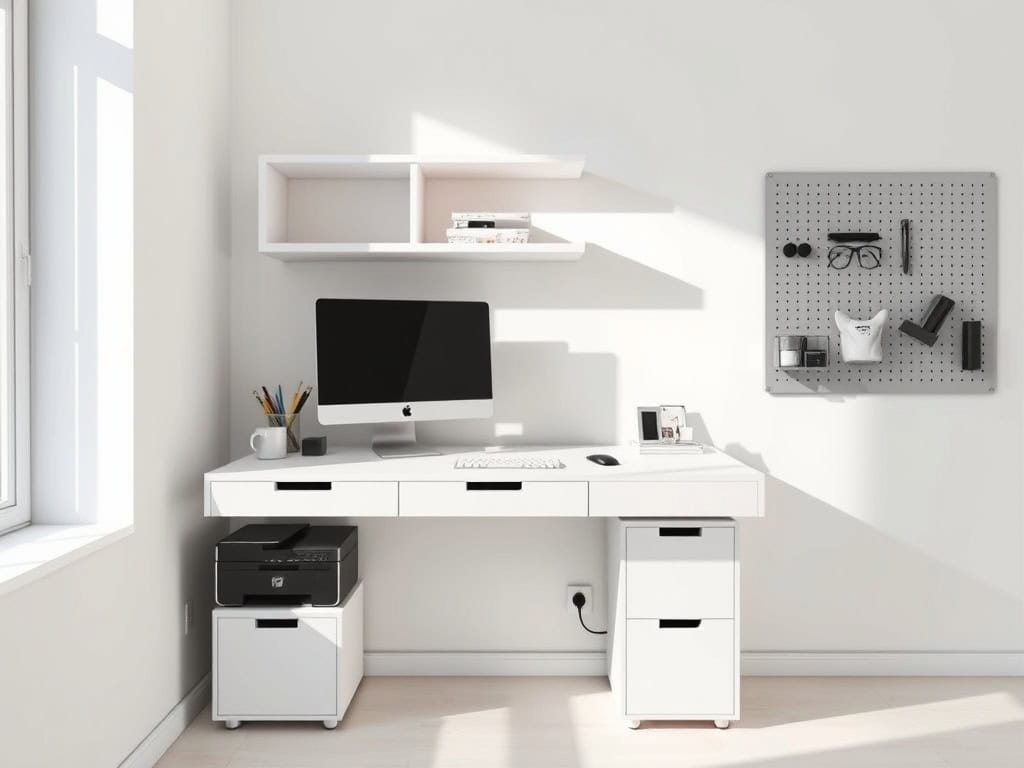Don’t let your cramped home office space hold you back from being productive! I’ve spent years mastering the art of small-space organization, and I’ve discovered that smart storage solutions can transform even the tiniest work area into an efficiency powerhouse. Whether you’re dealing with a converted closet or a cozy corner, these seven clever ideas will help you maximize every square inch while keeping your essentials within arm’s reach. Let me show you how to reclaim your workspace.
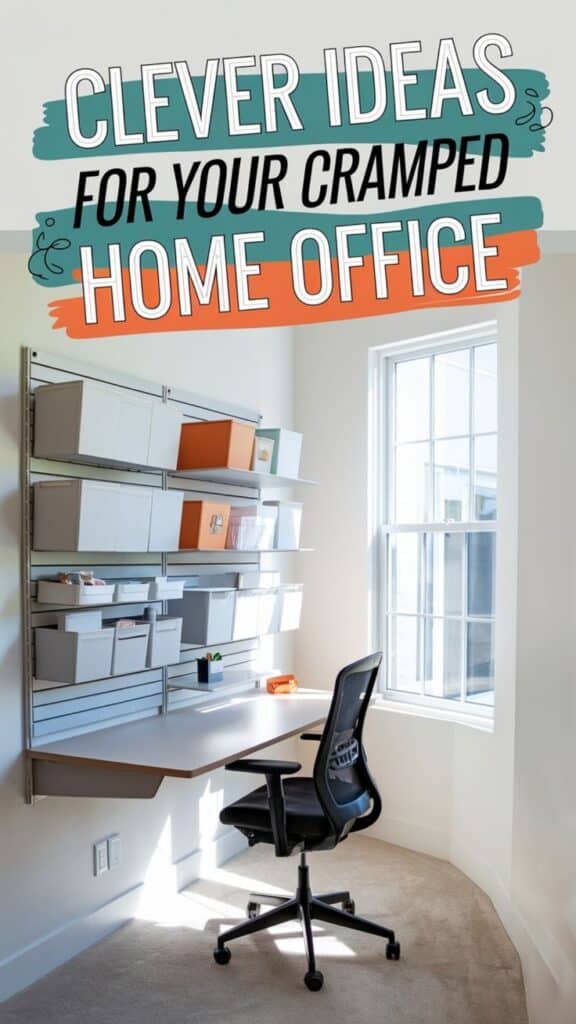
Vertical Wall Storage Solutions
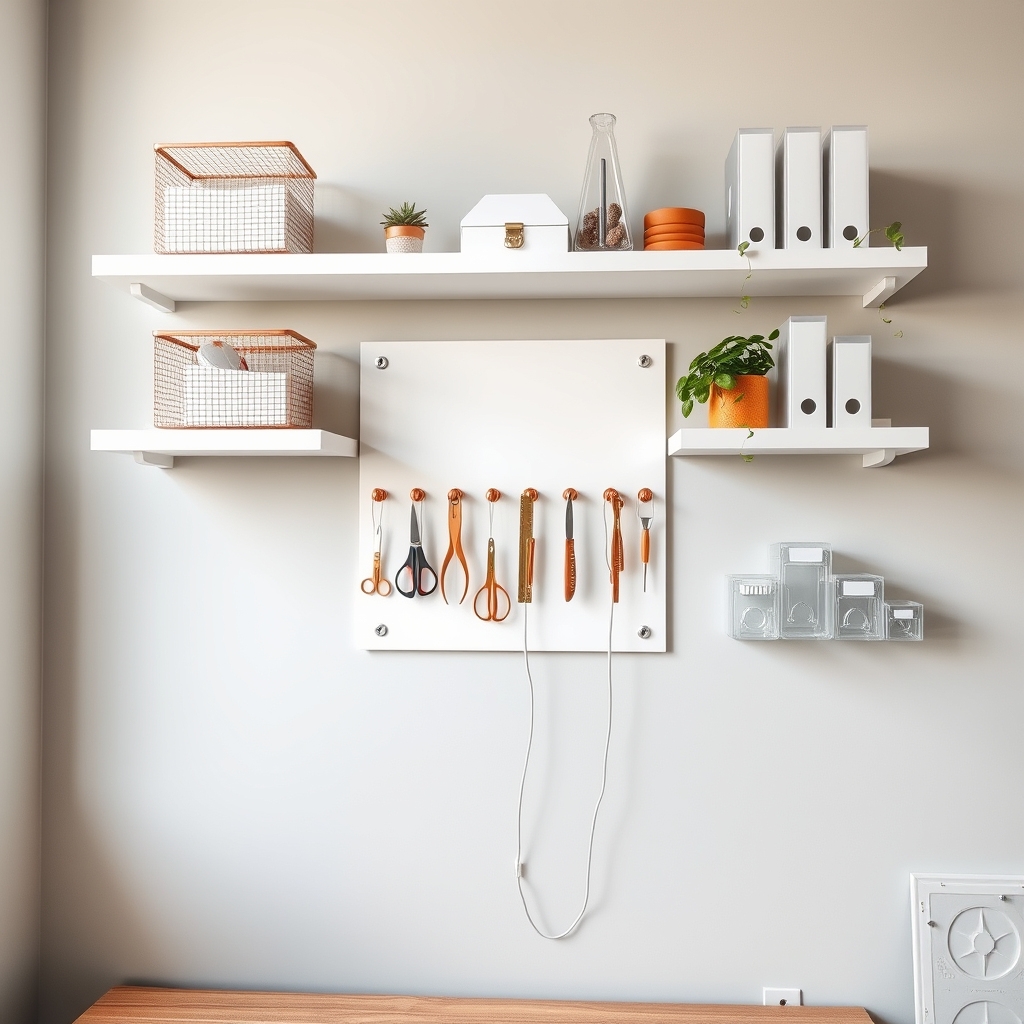
Making the most of vertical wall space is crucial in any home office, particularly when floor space is limited. Proper vertical storage not only maximizes your available space but also keeps essential items within arm’s reach while maintaining a clean, professional atmosphere.
Vertical wall storage transforms previously unused wall space into functional storage areas, reducing desktop clutter and creating a more organized workflow. This approach to organization helps maintain focus and productivity by keeping supplies visible yet orderly, while freeing up valuable surface area for active work.
Required Items:
- Wall studs finder
- Level
- Drill and drill bits
- Screwdriver
- Wall anchors
- Mounting brackets
- Floating shelves
- Pegboard and hooks
- Wall-mounted file holders
- Cable management strips
- Measuring tape
- Pencil
- Wire baskets or bins
Start by mapping out your wall space, using the stud finder to locate secure mounting points. Install floating shelves at varying heights, ensuring they’re level and properly anchored. Position the most frequently used items at eye level, with less-accessed items stored higher up.
Mount a pegboard system between shelves for adaptable storage of smaller items and tools. For paper management, install wall-mounted file holders below eye level for easy access. Utilize vertical cable management strips to keep cords organized and prevent them from tangling.
Add wire baskets or bins to shelves for storing smaller items and creating designated spaces for different categories of supplies. Consider incorporating a combination of open and closed storage solutions to maintain a clean appearance while keeping frequently used items visible.
Label all storage containers clearly, and establish a regular maintenance schedule to prevent clutter from accumulating. Periodically reassess your storage needs and adjust the layout to accommodate changing work patterns and requirements.
Desk With Built-In Organization
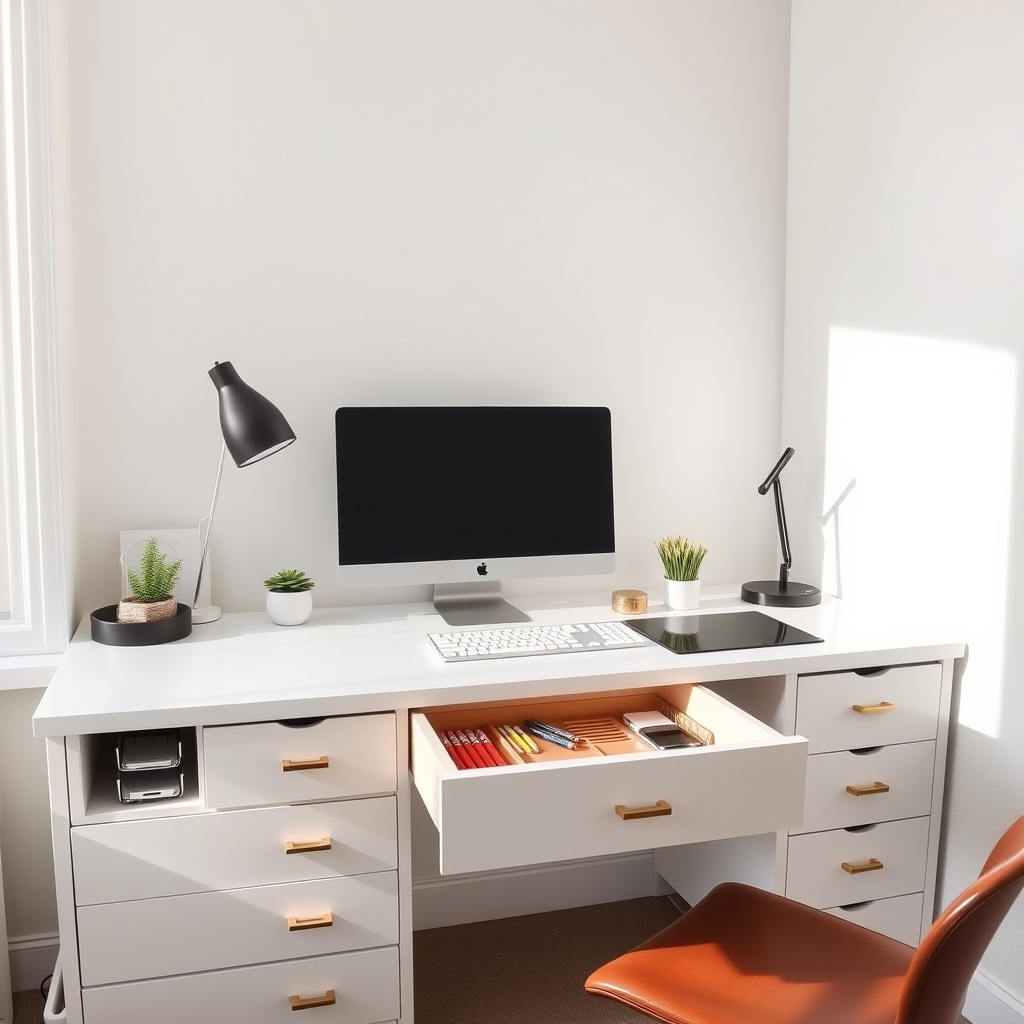
A well-organized desk serves as the command center for productivity in any home office. When every item has its designated space, you eliminate the daily frustration of searching for essential tools and documents, allowing you to focus entirely on your work tasks.
Built-in desk organization transforms a standard workspace into an efficient system that maintains order throughout your workday. By maximizing the existing storage features of your desk and implementing smart organizational solutions, you can create a streamlined environment that enhances both productivity and creativity.
Required Items:
- Drawer dividers
- File folders
- Cable management clips
- Desktop organizer tray
- Pen/pencil holder
- Letter tray
- Small containers for paper clips and supplies
- Labels
- Drawer liner
- Document stands
- USB hub
Start by completely clearing your desk surface and emptying all drawers. Install drawer dividers to create distinct sections for different categories of items. Designate the top drawer for frequently used supplies like writing tools, staplers, and sticky notes. Convert the bottom drawer into a filing system using hanging folders organized by category or priority. Line each drawer with non-slip material to prevent items from sliding around.
For the desktop surface, position your monitor at eye level and establish three distinct zones: primary (immediate work area), secondary (frequently accessed items), and storage (less-used items). Install cable management clips along the desk’s edge to keep cords organized and prevent tangling. Place your desktop organizer tray in the secondary zone, ensuring essential items remain within arm’s reach without cluttering your primary workspace.
Additional Tips: Implement a weekly maintenance routine to prevent organizational decay. Every Friday, spend 10 minutes returning items to their designated spots, emptying the letter tray, and reassessing the relevance of stored items.
Consider using color-coding for different project categories and maintain a “one in, one out” policy to prevent accumulation of unnecessary items. Position your most-used items on your dominant side to maximize efficiency in daily tasks.
Hidden Storage Furniture
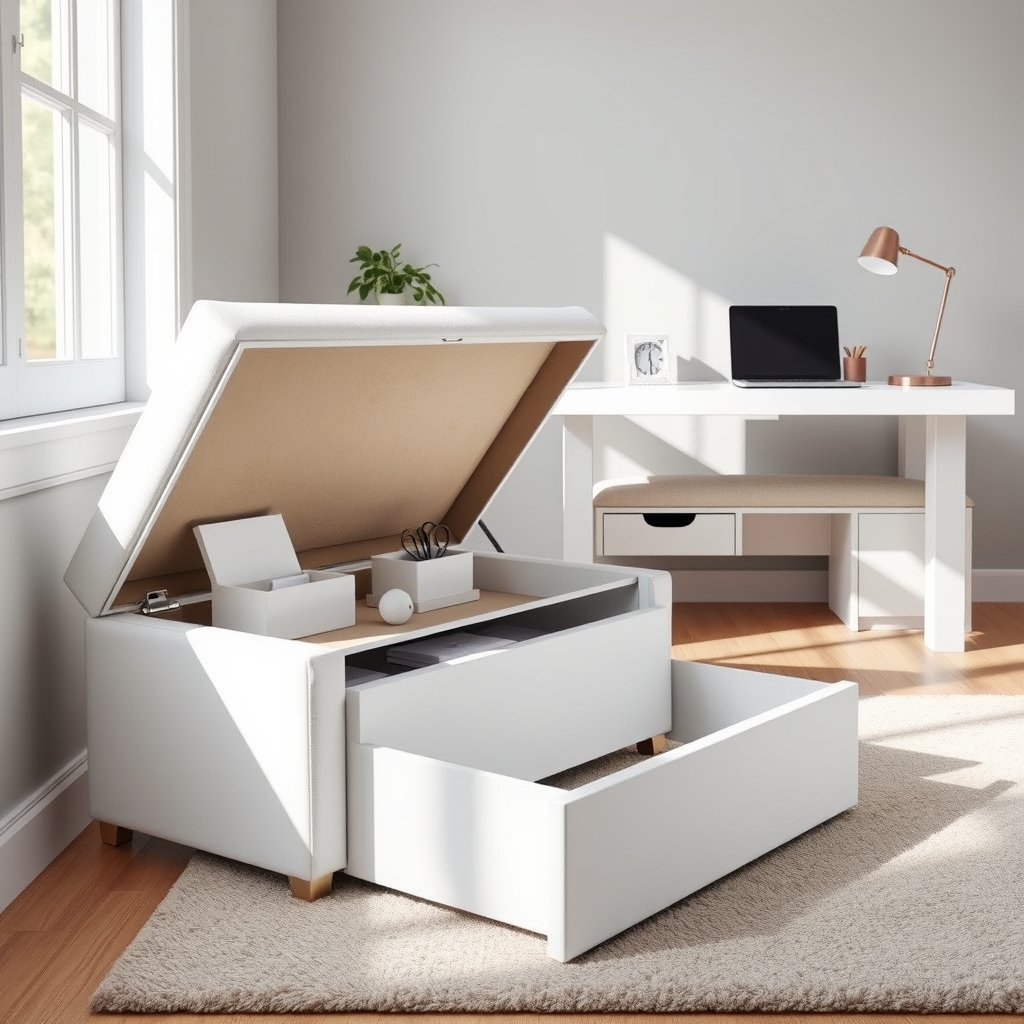
Hidden storage furniture represents a game-changing solution for maintaining a clutter-free and professional home office environment. By incorporating dual-purpose furniture pieces that conceal storage space, you can maximize your workspace while keeping essential items within arm’s reach but out of sight.
The strategic use of hidden storage furniture not only helps maintain a minimalist aesthetic but also contributes to improved focus and productivity. When supplies, documents, and equipment are thoughtfully tucked away in specially designed furniture pieces, your mind can better concentrate on tasks without visual distractions.
Required Items:
- Ottoman with storage compartment
- Hollow bench seating
- Desk with built-in drawers or compartments
- Storage bed frame (if office is in bedroom)
- Multi-functional coffee table
- Label maker
- Storage containers
- Drawer organizers
- Measuring tape
- Space-planning diagram
Begin by measuring your office space and creating a floor plan that identifies prime locations for hidden storage furniture. Position larger pieces like storage ottomans or benches against walls where they won’t impede traffic flow. Install desk systems with built-in storage features, ensuring frequently used items are stored in easily accessible compartments.
Sort office supplies, documents, and equipment into categories, then assign specific storage zones within each furniture piece. When organizing items within hidden storage furniture, implement a system where similar items are grouped together. Use drawer organizers and containers to subdivide larger storage spaces, making it easier to maintain order.
Label all compartments clearly to ensure items can be quickly located and returned to their designated spots. For optimal organization maintenance, establish a weekly routine to review and tidy hidden storage areas. Keep a detailed inventory of stored items and their locations, particularly for seasonal or infrequently used supplies.
Consider rotating items based on usage patterns, moving frequently accessed materials to more accessible areas while storing rarely used items in deeper storage compartments.
Mobile Filing Systems

In today’s dynamic work environment, the ability to access important documents while maintaining flexibility in your workspace is crucial. Mobile filing systems represent the perfect solution for home offices where space is at a premium or where work needs to move between different areas of the house. These systems allow for efficient document management while adapting to changing needs and space constraints.
A well-organized mobile filing system not only keeps documents secure and accessible but also helps maintain productivity by eliminating time wasted searching for important papers. Whether you’re working from a dedicated home office or need to transition between different spaces throughout the day, a properly structured mobile filing system can make a significant difference in your work efficiency.
Required Items:
- Rolling file cart
- Hanging file folders
- File folder labels
- Document organizers
- Filing box dividers
- Colored tabs
- Clear plastic sleeves
- File folder rings
- Label maker
- Archive boxes
Start by categorizing your documents into three main groups: frequently accessed, occasionally needed, and archival materials. Assign each category a specific color or label system for easy identification. Set up your rolling file cart with hanging folders, ensuring the most frequently accessed files are positioned at the front for quick retrieval.
Create a logical filing system within each section, using alphabetical, chronological, or project-based organization depending on your specific needs. For maximum mobility, consider using lightweight, clear containers for documents that need to travel between spaces. Implement a check-out system if multiple family members need access to the files, using a simple log to track document movement.
Ensure all folders are clearly labeled and consider creating a master index of your filing system that can be kept in both digital and physical formats.
Additional Tips: Review your mobile filing system quarterly to maintain its effectiveness. Regularly purge unnecessary documents and update your organizational system as needed. Consider scanning important documents to create digital backups, and store these files in a cloud-based system for additional security and accessibility.
Keep frequently used supplies like staplers, paper clips, and extra folders in an attached organizer on your mobile cart to create a truly self-contained mobile office solution.
Multi-Purpose Office Accessories

In today’s hybrid work environment, maximizing office space through multi-purpose accessories has become essential for maintaining an organized and efficient workspace. When office items serve multiple functions, they not only save valuable desk and storage space but also reduce clutter and streamline workflow.
Multi-purpose office accessories represent a smart investment in workspace organization, allowing professionals to accomplish more tasks with fewer items while maintaining a clean aesthetic. These versatile tools can transform a cramped office into a highly functional space that adapts to various work needs throughout the day.
Required Items:
- Desktop organizer with adjustable compartments
- Stackable file holders
- Magnetic whiteboard/bulletin board combo
- Rolling cart with multiple tiers
- Desk pad with built-in storage
- Monitor stand with storage drawers
- Cable management system with power strip
- Expandable file folders
- Wall-mounted storage rails
- Multi-compartment storage boxes
Start by assessing your current office accessories and identify items that can be replaced with multi-functional alternatives. Position your monitor stand with storage drawers at the back of your desk, utilizing the drawers for frequently accessed supplies.
Install the magnetic whiteboard/bulletin board combo at eye level, using it for both planning and document display. Set up the rolling cart beside your desk, organizing supplies by frequency of use across different tiers.
Configure the desktop organizer with adjustable compartments to accommodate both traditional office supplies and technology accessories. Implement the cable management system along the desk’s edge, incorporating the power strip to create a clean, accessible power solution.
Mount storage rails on nearby walls to hold both hanging files and attachable containers for supplies. For optimal results, regularly evaluate how you use each multi-purpose accessory and adjust its configuration based on your workflow patterns.
Consider seasonal needs when organizing supplies, and maintain clear labels on all storage components. Remember to periodically purge unused items to prevent clutter from accumulating, ensuring your multi-purpose accessories continue functioning efficiently for their intended uses.
Behind-the-Door Organization
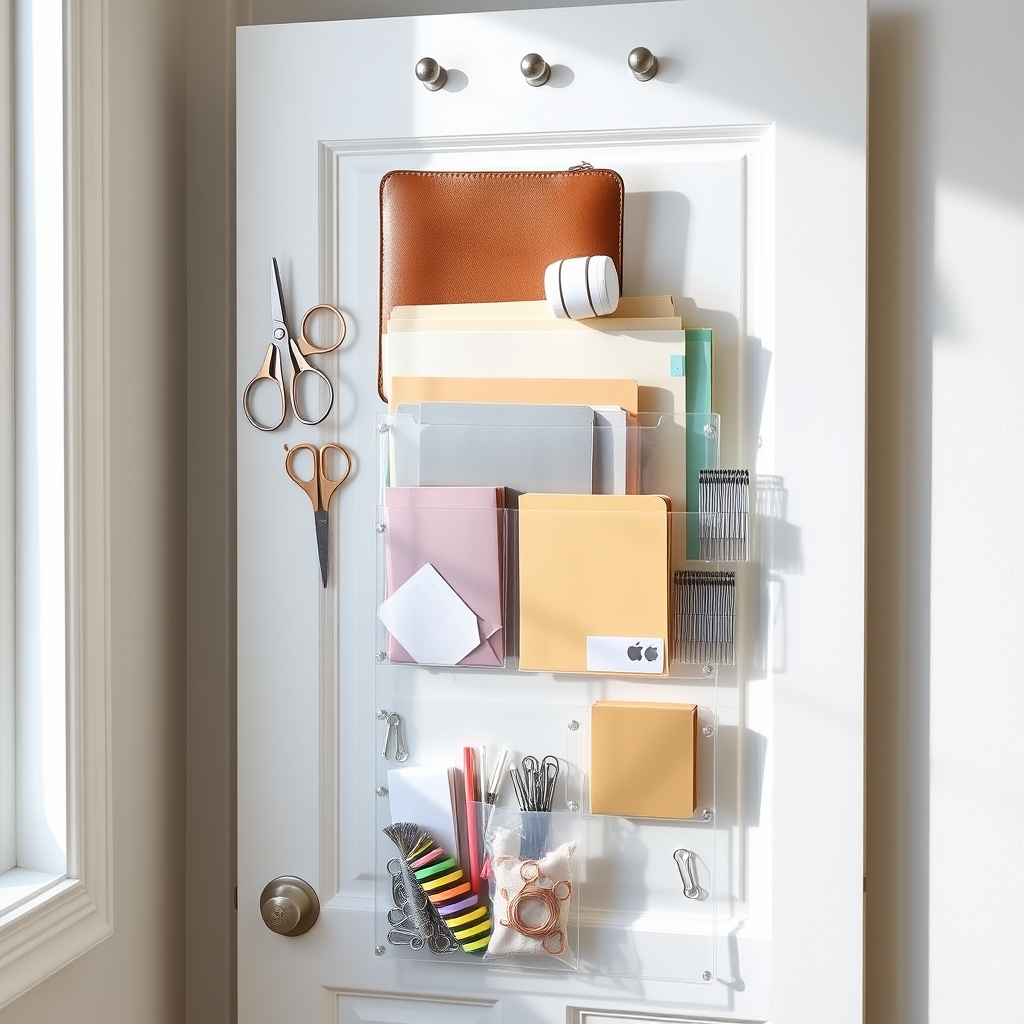
Making the most of every available space is crucial in a home office, and the often-overlooked door area presents a golden opportunity for additional storage. Behind-the-door organization systems can effectively double your storage capacity without taking up valuable floor or desk space, creating a streamlined and efficient work environment.
The vertical space provided by your office door can accommodate everything from files and supplies to tech accessories and personal items. This storage solution is particularly valuable for small home offices or shared spaces where maximizing every inch is essential for maintaining productivity and organization.
Required Items:
- Over-the-door organizer with clear pockets
- Over-the-door hooks or rack system
- Command hooks or mounting hardware
- Storage baskets or containers
- Label maker or labels
- Measuring tape
- Door-mounted file holder
- Small storage bins
- Cable ties or organizers
Start by measuring your door’s dimensions, including width and available hanging space, ensuring adequate clearance for the door to close properly with organizers installed.
Install an over-the-door organizing system, positioning it at a comfortable height for easy access. Sort office supplies, documents, and accessories into categories before placing them in the organizer pockets or baskets. Use clear pockets for frequently accessed items and ensure heavier items are stored in lower compartments for stability.
Create designated zones within your door organization system, such as supplies, pending documents, and frequently used items. Label each pocket or section clearly to maintain organization and make items easy to locate.
Consider using different heights for various storage solutions – hooks at the top for headphones or bags, file holders at eye level, and supply storage at arm’s reach.
For optimal organization, regularly assess and rotate items based on frequency of use, keeping the most-needed supplies at eye level. Consider seasonal adjustments to your storage system, and implement a monthly review to prevent clutter accumulation.
Remember to test the door’s movement after installation and make adjustments as needed to prevent any interference with door function or potential damage to stored items.
Under-Desk Storage Maximization
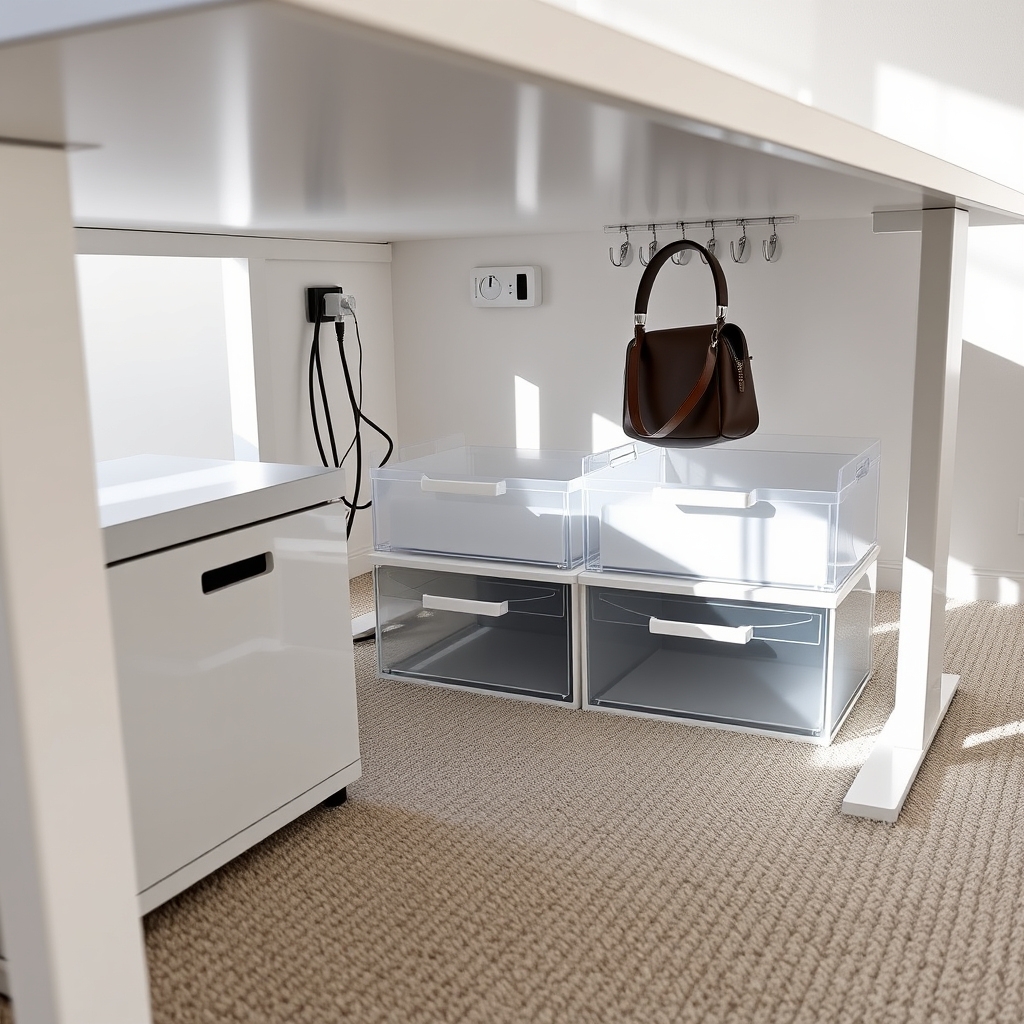
A well-organized under-desk space is crucial for maintaining a productive and clutter-free home office environment. The often-overlooked area beneath your desk represents valuable real estate that, when properly utilized, can significantly expand your storage capacity while keeping essential items within arm’s reach.
Maximizing under-desk storage not only helps create a more organized workspace but also contributes to better focus and reduced stress levels. By implementing strategic storage solutions, you can transform this typically chaotic space into an efficient storage system that complements your work style and enhances your daily workflow.
Required Items:
- File boxes or drawers
- Cable management solutions
- Under-desk drawer unit
- Desk-mounted hooks
- Storage bins
- Label maker
- Measuring tape
- Drawer organizers
- Power strip mount
- Cable ties
Start by measuring your under-desk space, accounting for leg room and movement area. Install a mounted drawer unit or file cabinet that fits within these dimensions, ensuring it doesn’t interfere with your sitting position.
Position frequently accessed items in the top drawers and less-used materials in lower compartments. Create designated zones for different categories of items, such as office supplies, documents, and technology accessories.
Next, address cable management by installing a mounted power strip and using cable ties or sleeves to bundle cords together. Attach hooks to the desk’s underside for hanging headphones, bags, or other accessories.
Utilize vertical space by adding stackable storage containers that can be easily pulled out when needed.
Additional Tips: Consider using clear containers to easily identify contents, and implement a regular maintenance schedule to prevent clutter accumulation.
Review stored items quarterly to eliminate unnecessary items and reorganize based on changing needs. Leave enough space for comfortable leg movement and proper air circulation around any electronic equipment stored in the area.

